Displacement-Dependent Damping Inerter System for Seismic Response Control
Abstract
:1. Introduction
2. Theoretical Analysis of Displacement-Dependent Damping Inerter System (DDIS)
2.1. Mechanical Model
2.1.1. Model of Displacement-Dependent Damping Element (DDE)
2.1.2. Model of DDIS
2.2. Equations of Motion
2.3. Stochastic Dynamic Analysis and Stochastic Linearization Method
2.4. Energy Balance Analysis
3. Characteristics of DDIS
3.1. Stochastic Performance Indices
3.2. Parametric Analysis of DDIS
3.2.1. Influence of Excitation Severity
3.2.2. Influence of DDIS Parameters
3.2.3. Influence of Structural Parameters
4. Non-Linear Time-History Analysis and Performance of DDIS
4.1. Displacement Mitigation Effect in Early Stage of Seismic Response
4.2. Seismic Performance of Structure Equipped with DDIS
5. Conclusions
- The DDIS is observed to suppress the structural responses in a timely manner as soon as a peak response occurs during the early stage of the excitation. The proposed equivalent linearization method is effective to conduct the stochastic dynamic analysis of the DDIS-equipped structure. The dynamic response of the DDIS controlled systems are further evaluated in the time domain considering the non-linearity and validating the accuracy of the stochastic analysis.
- The interaction between the inerter, spring and the DDE constitutes the damping enhancement mechanism of the DDIS. Compared with an identical DDE, the proposed mechanism amplifies the deformation of the DDE in the DDIS by over 60%; thus, the DDIS is characterized by a higher energy dissipation capability.
- The proposed DDIS considerably reduces the structural displacement and acceleration, which is a result of its damping and mass-enhancement mechanism. For the DDIS with medium value of stiffness ratio and inertance-mass ratio, the displacement and acceleration responses of original uncontrolled structure are reduced by 60% and 40%, respectively.
- The benefits and characteristics of the proposed DDIS are obtained from an extensive parametric analysis and not limited to any specific optimal design procedures. Further studies should be conducted on the parameter design methodology and practical design procedure of the DDIS. The equivalent linearization method proposed in this paper would help reduce the computational cost required to develop a design method.
Author Contributions
Funding
Acknowledgments
Conflicts of Interest
References
- Ikago, K.; Saito, K.; Inoue, N. Seismic control of single-degree-of-freedom structure using tuned viscous mass damper. Earthq. Eng. Struct. Dyn. 2012, 41, 453–474. [Google Scholar] [CrossRef]
- Zhao, Z.P.; Zhang, R.F.; Lu, Z. A particle inerter system for structural seismic response mitigation. J. Frankl. Inst. 2019, 256, 7669–7688. [Google Scholar] [CrossRef]
- Zhao, Z.P.; Chen, Q.J.; Zhang, R.F.; Pan, C.; Jiang, Y.Y. Optimal design of an inerter isolation system considering the soil condition. Eng. Struct. 2019, 196, 109324. [Google Scholar] [CrossRef]
- Brzeski, P.; Kapitaniak, T.; Perlikowski, P. Novel type of tuned mass damper with inerter which enables changes of inertance. J. Sound. Vib. 2015, 349, 56–66. [Google Scholar] [CrossRef]
- Málaga-Chuquitaype, C.; Menendez-Vicente, C.; Thiers-Moggia, R. Experimental and numerical assessment of the seismic response of steel structures with clutched inerters. Soil Dyn. Earthq. Eng. 2019, 121, 200–211. [Google Scholar] [CrossRef]
- Masri, S.F.; Caffrey, J.P. Transient response of a sdof system with an inerter to nonstationary stochastic excitation. J. Appl. Mech.-T Asme 2017, 84, 041005. [Google Scholar] [CrossRef]
- Taflanidis, A.A.; Giaralis, A.; Patsialis, D. Multi-objective optimal design of inerter-based vibration absorbers for earthquake protection of multi-storey building structures. J. Frankl. Inst. 2019, 356, 7754–7784. [Google Scholar] [CrossRef]
- Petrini, F.; Giaralis, A.; Wang, Z. Optimal tuned mass-damper-inerter (TMDI) design in wind-excited tall buildings for occupants’ comfort serviceability performance and energy harvesting. Eng. Struct. 2019, 109904. [Google Scholar] [CrossRef]
- Luo, H.; Zhang, R.F.; Weng, D.G. Mitigation of liquid sloshing in storage tanks by using a hybrid control method. Soil Dyn. Earthq. Eng. 2016, 90, 183–195. [Google Scholar] [CrossRef]
- Zhang, R.F.; Zhao, Z.P.; Pan, C. Influence of mechanical layout of inerter systems on seismic mitigation of storage tanks. Soil Dyn. Earthq. Eng. 2018, 114, 639–649. [Google Scholar] [CrossRef]
- Jiang, Y.Y.; Zhao, Z.P.; Zhang, R.F.; De Domenico, D.; Pan, C. Optimal design based on analytical solution for storage tank with inerter isolation system. Soil Dyn. Earthq. Eng. 2019. [Google Scholar] [CrossRef]
- Hu, Y.; Wang, J.; Chen, M.Z.Q.; Li, Z.; Sun, Y. Load mitigation for a barge-type floating offshore wind turbine via inerter-based passive structural control. Eng. Struct. 2018, 177, 198–209. [Google Scholar] [CrossRef]
- Zhang, R.F.; Zhao, Z.P.; Dai, K. Seismic response mitigation of a wind turbine tower using a tuned parallel inerter mass system. Eng. Struct. 2019, 180, 29–39. [Google Scholar] [CrossRef]
- Sarkar, S.; Fitzgerald, B. Vibration control of spar-type floating offshore wind turbine towers using a tuned mass-damper-inerter. Struct. Control Health Monit. 2020, 27, e2471. [Google Scholar] [CrossRef]
- Ma, R.; Bi, K.; Hao, H. Mitigation of heave response of semi-submersible platform (SSP) using tuned heave plate inerter (THPI). Eng. Struct. 2018, 177, 357–373. [Google Scholar] [CrossRef]
- Lazar, I.F.; Neild, S.A.; Wagg, D.J. Vibration suppression of cables using tuned inerter dampers. Eng. Struct. 2016, 122, 62–71. [Google Scholar] [CrossRef] [Green Version]
- Luo, J.N.; Jiang, J.Z.; Macdonald, J.H.G. Cable vibration suppression with inerter-based absorbers. J. Eng. Mech. 2019, 145, 15. [Google Scholar] [CrossRef] [Green Version]
- Wang, F.C.; Lee, C.H.; Zheng, R.Q. Benefits of the inerter in vibration suppression of a milling machine. J. Frankl. Inst. 2019, 356, 766. [Google Scholar] [CrossRef]
- Scheibe, F.; Smith, M.C. Analytical solutions for optimal ride comfort and tyre grip for passive vehicle suspensions. Vehicle. Syst. Dyn. 2009, 47, 1229–1252. [Google Scholar] [CrossRef]
- Shen, Y.; Chen, L.; Yang, X.; Shi, D.; Yang, J. Improved design of dynamic vibration absorber by using the inerter and its application in vehicle suspension. J. Sound. Vib. 2016, 361, 148–158. [Google Scholar] [CrossRef]
- Smith, M.C. Synthesis of mechanical networks: The inerter. IEEE T Automat. Contr. 2002, 47, 1648–1662. [Google Scholar] [CrossRef] [Green Version]
- Chen, M.Z.Q.; Hu, Y.; Huang, L.; Chen, G. Influence of inerter on natural frequencies of vibration systems. J. Sound. Vib. 2014, 333, 1874–1887. [Google Scholar] [CrossRef] [Green Version]
- Krenk, S. Resonant inerter based vibration absorbers on flexible structures. J. Frankl. Inst. 2019, 356, 7704–7730. [Google Scholar] [CrossRef]
- Chen, Q.J.; Zhao, Z.P.; Xia, Y.Y.; Pan, C.; Luo, H.; Zhang, R.F. Comfort-based floor design employing tuned inerter mass system. J. Sound. Vib. 2019, 458, 143–157. [Google Scholar] [CrossRef]
- Zhao, Z.P.; Zhang, R.F.; Jiang, Y.Y.; Pan, C. A tuned liquid inerter system for vibration control. Int. J. Mech. Sci. 2019, 164, 105171. [Google Scholar] [CrossRef]
- Kawamata, S. Development of a Vibration Control System of Structures by Means of Mass Pumps; Institute of Industrial Science, University of Tokyo: Tokyo, Japan, 1973. [Google Scholar]
- Arakaki, T.; Kuroda, H.; Arima, F.; Inoue, Y.; Baba, K. Development of seismic devices applied to ball screw: Part 1 basic performance test of rd-series. J. Archit. Build. Sci. 1999, 5, 239–244. [Google Scholar]
- Arakaki, T.; Kuroda, H.; Arima, F.; Inoue, Y.; Baba, K. Development of seismic devices applied to ball screw: Part 2 performance test and evaluation of rd-series. J. Archit. Build. Sci. 1999, 9, 265–270. [Google Scholar]
- Saito, K.; Inoue, N. A study on optimum response control of passive control systems using viscous damper with inertial mass: Substituting equivalent nonlinear viscous elements for linear viscous elements in optimum control systems. J. Techn. Des. 2007, 13, 457–462. [Google Scholar]
- Garrido, H.; Curadelli, O.; Ambrosini, D. Improvement of tuned mass damper by using rotational inertia through tuned viscous mass damper. Eng. Struct. 2013, 56, 2149–2153. [Google Scholar] [CrossRef]
- Nakamura, Y.; Fukukita, A.; Tamura, K.; Yamazaki, I.; Matsuoka, T.; Hiramoto, K.; Sunakoda, K. Seismic response control using electromagnetic inertial mass dampers. Earthq. Eng. Struct. Dyn. 2014, 43, 507–527. [Google Scholar] [CrossRef]
- Asai, T.; Araki, Y.; Ikago, K. Energy harvesting potential of tuned inertial mass electromagnetic transducers. Mech. Syst. Signal. Pr. 2017, 84, 659–672. [Google Scholar] [CrossRef] [Green Version]
- Asai, T.; Araki, Y.; Ikago, K. Structural control with tuned inertial mass electromagnetic transducers. Struct Control Health Monit. 2018, 25, e2059. [Google Scholar] [CrossRef] [Green Version]
- Zhang, R.F. Seismic Response Analysis of Base-Isolated Vertical Tank; Tongji University: Shanghai, China, 2014. [Google Scholar]
- Pan, C.; Zhang, R.F.; Luo, H.; Li, C.; Shen, H. Demand-based optimal design of oscillator with parallel-layout viscous inerter damper. Struct. Control Health Monit. 2018, 25, e2051. [Google Scholar] [CrossRef]
- Pan, C.; Zhang, R.F. Design of structure with inerter system based on stochastic response mitigation ratio. Struct. Control Health Monit. 2018, 25, e2169. [Google Scholar] [CrossRef]
- Chen, Q.J.; Zhao, Z.P.; Zhang, R.F.; Pan, C. Impact of soil–structure interaction on structures with inerter system. J. Sound. Vib. 2018, 433, 1–15. [Google Scholar] [CrossRef]
- Kida, H.; Watanabe, Y.; Nakaminami, S.; Tanaka, H.; Sugimura, Y.; Saito, K.; Ikago, K.; Inoue, N. Full-scale dynamic tests of tuned viscous mass damper with force restriction mechanism and its analytical verification. J. Struct. Constr. Eng. 2011, 76, 1271–1280. [Google Scholar] [CrossRef] [Green Version]
- Chen, Y. Leaking analysis of fluid viscous damper for engineering structure. Steel Constr. 2008, 23, 53–58. [Google Scholar]
- Pong, W.S.; Tsai, C.S.; Lee, G.C. Seismic Study of Building Frames with Added Energy-Absorbing Devices; State University of New York at Buffalo: Buffalo, NY, USA, 1994; pp. 50–66. [Google Scholar]
- Kelly, J.M.; Skinner, M.S. A Review of Current Uses of Energy-Absorbing Devices; Earthquake Engineering Research Center, University of California at Berkeley: Berkeley, CA, USA, 1979. [Google Scholar]
- Makris, N. Rigidity–plasticity–viscosity: Can electrorheological dampers protect base-isolated structures from near-source ground motions? Earthq. Eng. Struct. Dyn. 1997, 26, 571–591. [Google Scholar] [CrossRef]
- Kelly, J.M.; Skinner, R.I.; Heine, A.J. Mechanics of energy absorption in special devices for use in earthquake resistant structures. Bull. New Zealand Soc. Earthq. Eng. 1972, 5, 63–88. [Google Scholar]
- Moreschi, L.M.; Singh, M.P. Design of yielding metallic and friction dampers for optimal seismic performance. Earthq. Eng. Struct. Dyn. 2010, 32, 1291–1311. [Google Scholar] [CrossRef]
- Sauter, D.; Hagedorn, P. On the hysteresis of wire cables in stockbridge dampers. Int. J. Non-linear Mech. 2002, 37, 1453–1459. [Google Scholar] [CrossRef]
- Carpineto, N.; Lacarbonara, W.; Vestroni, F. Hysteretic tuned mass dampers for structural vibration mitigation. J. Sound. Vib. 2014, 333, 1302–1318. [Google Scholar] [CrossRef]
- Yamamoto, M.; Sone, T. Damping systems that are effective over a wide range of displacement amplitudes using metallic yielding component and viscoelastic damper in series. Earthq. Eng. Struct. Dyn. 2015, 43, 2097–2114. [Google Scholar] [CrossRef]
- Saito, K.; Sugimura, Y.; Inoue, N. A study on response control of a structure using viscous damper with inertial mass. J. Struct. Eng. 2008, 54, 635–648. [Google Scholar]
- De Domenico, D.; Deastra, P.; Ricciardi, G.; Sims, N.D.; Wagg, D.J. Novel fluid inerter based tuned mass dampers for optimised structural control of base-isolated buildings. J. Frankl. Inst. 2019, 356, 7626–7649. [Google Scholar] [CrossRef] [Green Version]
- Gonzalez-Buelga, A.; Clare, L.R.; Neild, S.A.; Jiang, J.Z.; Inman, D.J. An electromagnetic inerter-based vibration suppression device. Smart Mater. Struct. 2015, 24, 055015. [Google Scholar] [CrossRef]
- Takewaki, I.; Murakami, S.; Yoshitomi, S.; Tsuji, M. Fundamental mechanism of earthquake response reduction in building structures with inertial dampers. Struct. Control Health Monit. 2012, 19, 590–608. [Google Scholar] [CrossRef]
- Javidialesaadi, A.; Wierschem, N.E. Optimal design of rotational inertial double tuned mass dampers under random excitation. Eng. Struct. 2018, 165, 412–421. [Google Scholar] [CrossRef]
- Basili, M.; De Angelis, M.; Pietrosanti, D. Defective two adjacent single degree of freedom systems linked by spring-dashpot-inerter for vibration control. Eng. Struct. 2019, 188, 480–492. [Google Scholar] [CrossRef]
- Zhao, Z.P.; Zhang, R.F.; Jiang, Y.Y.; Pan, C. Seismic response mitigation of structures with a friction pendulum inerter system. Eng. Struct. 2019, 193, 110–120. [Google Scholar] [CrossRef]
- Faraj, R.; Jankowski, L.; Graczykowski, C.; Holnicki-Szulc, J. Can the inerter be a successful shock-absorber? The case of a ball-screw inerter with a variable thread lead. J. Frankl. Inst. 2019, 356, 7855–7872. [Google Scholar] [CrossRef]
- Kras, A.; Gardonio, P. Active vibration control unit with a flywheel inertial actuator. J. Sound Vib. 2020, 464, 114987. [Google Scholar] [CrossRef]
- De Domenico, D.; Ricciardi, G. Optimal design and seismic performance of tuned mass damper inerter (tmdi) for structures with nonlinear base isolation systems. Earthq. Eng. Struct. Dyn. 2018, 47, 2539–2560. [Google Scholar]
- De Domenico, D.; Impollonia, N.; Ricciardi, G. Soil-dependent optimum design of a new passive vibration control system combining seismic base isolation with tuned inerter damper. Soil Dyn. Earthq. Eng. 2018, 105, 37–53. [Google Scholar] [CrossRef]
- Buchholdt, H. Structural Dynamics for Engineers; Thomas Teldfort: London, UK, 1997. [Google Scholar]
- Noori, M.N.; Saffar, A.; Davoodi, H. A comparison between non-gaussian closure and statistical linearization techniques for random vibration of a nonlinear oscillator. Comput. Struct. 1987, 26, 925–931. [Google Scholar] [CrossRef]
- Wen, Y.K. Equivalent linearization for hysteretic systems under random excitation. J. Appl. Mech. 1980, 47, 150–154. [Google Scholar] [CrossRef]
- Roberts, J.B.; Spanos, P.D. Random Vibration and Statistical Linearization; Wiley: New York, NY, USA, 1990. [Google Scholar]
- Castaldo, P.; Ripani, M.; Priore, R.L. Influence of soil conditions on the optimal sliding friction coefficient for isolated bridges. Soil Dyn. Earthq. Eng. 2018, 111, 131–148. [Google Scholar] [CrossRef]

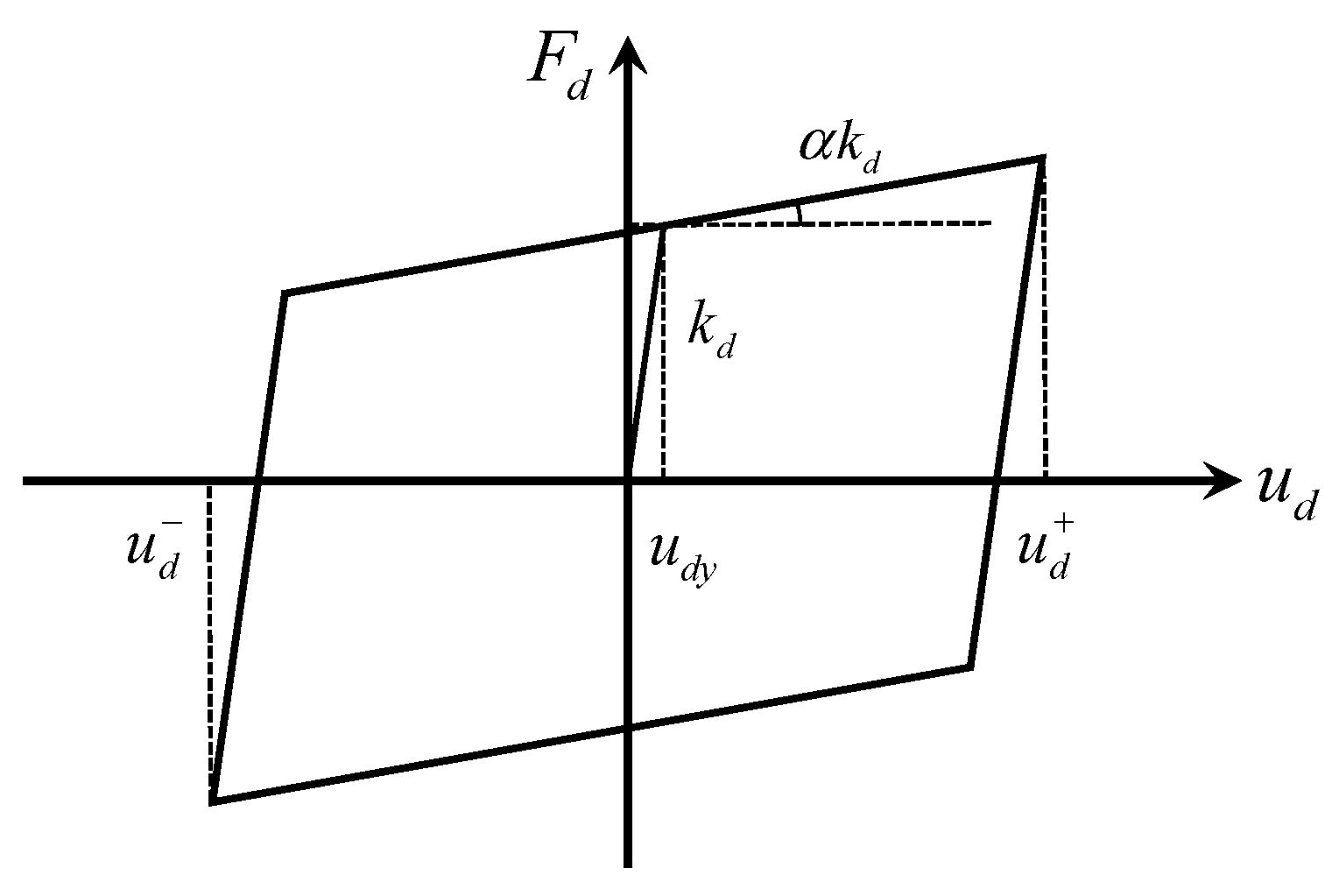
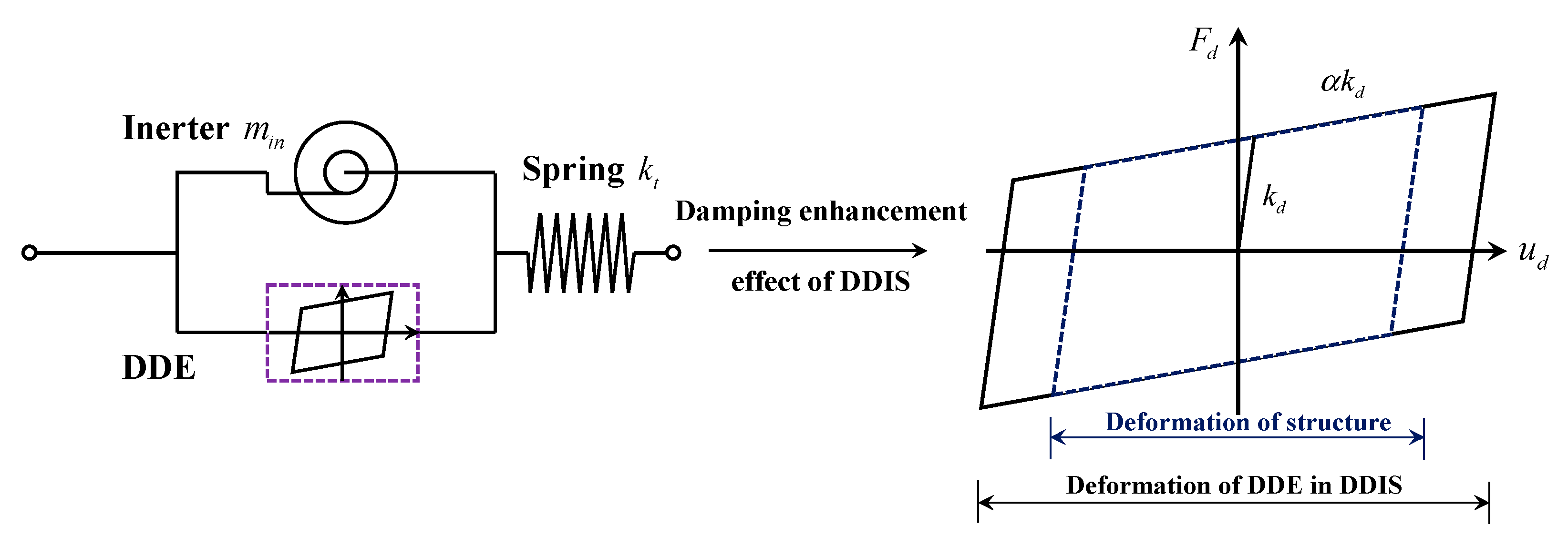

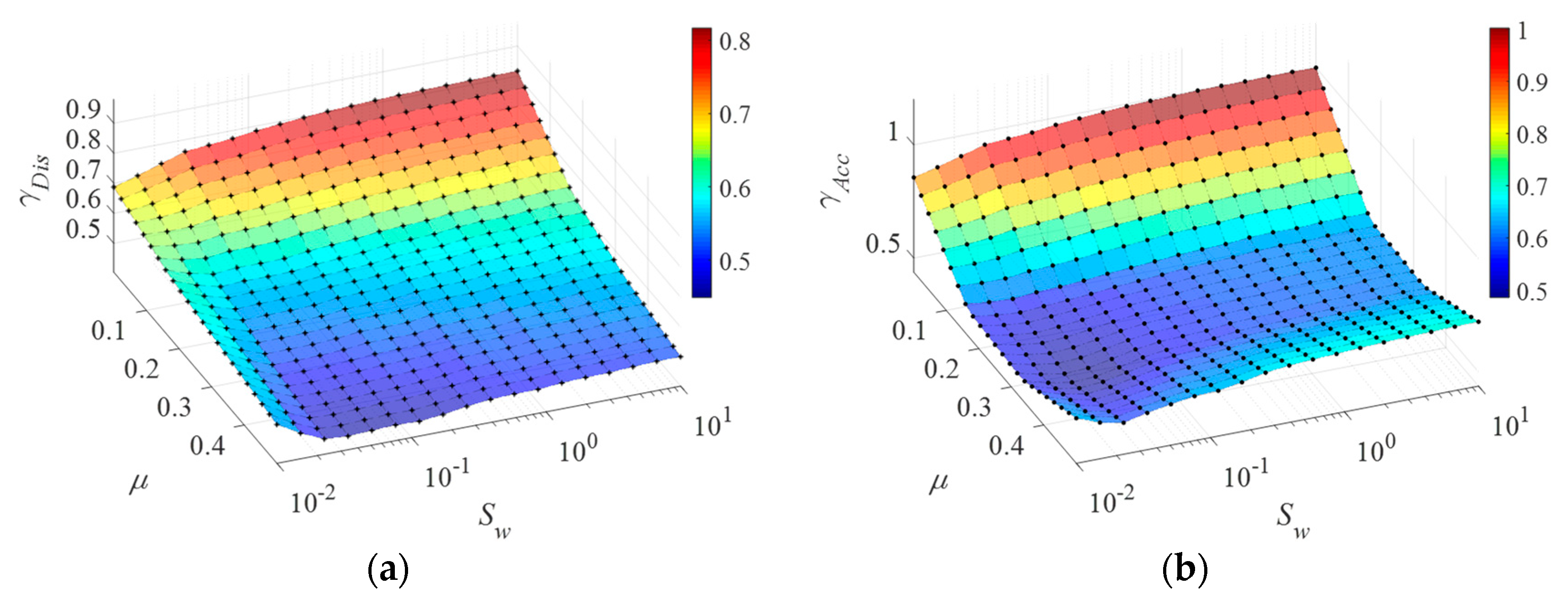
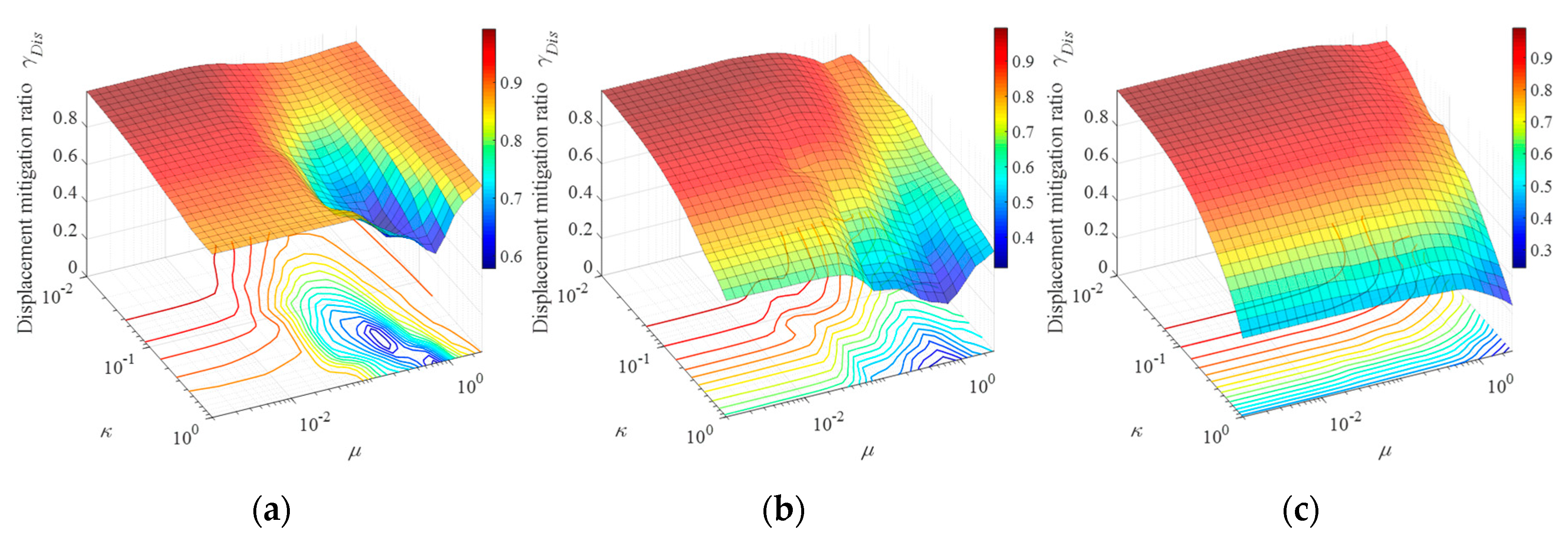

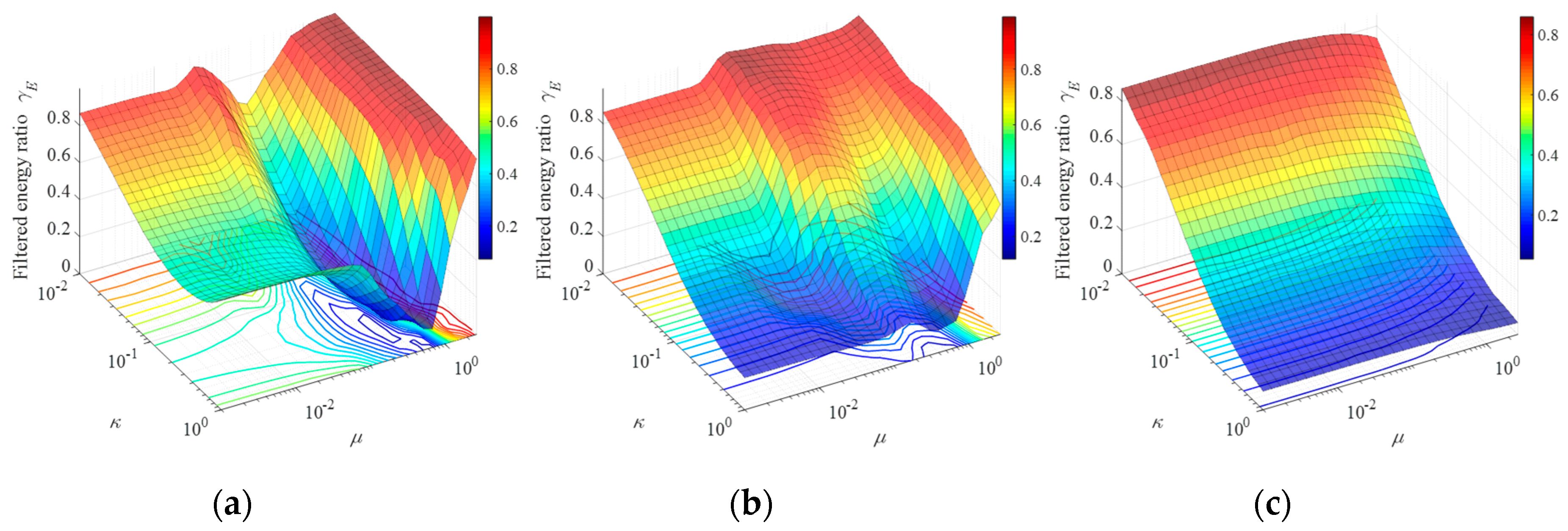
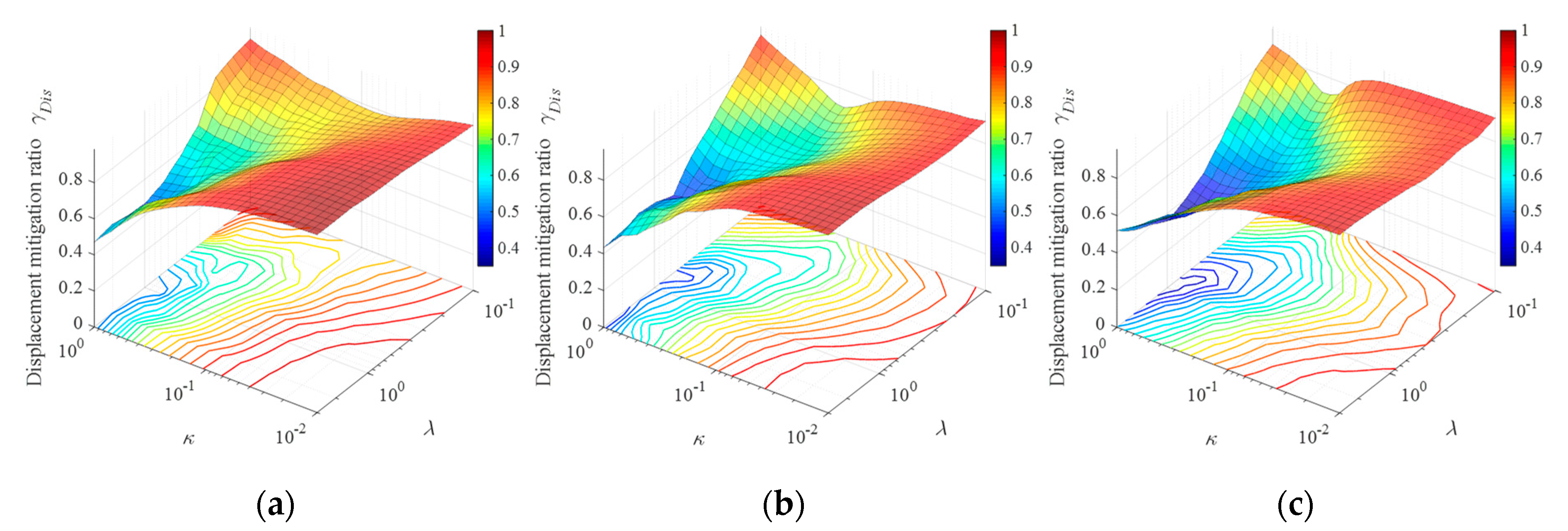
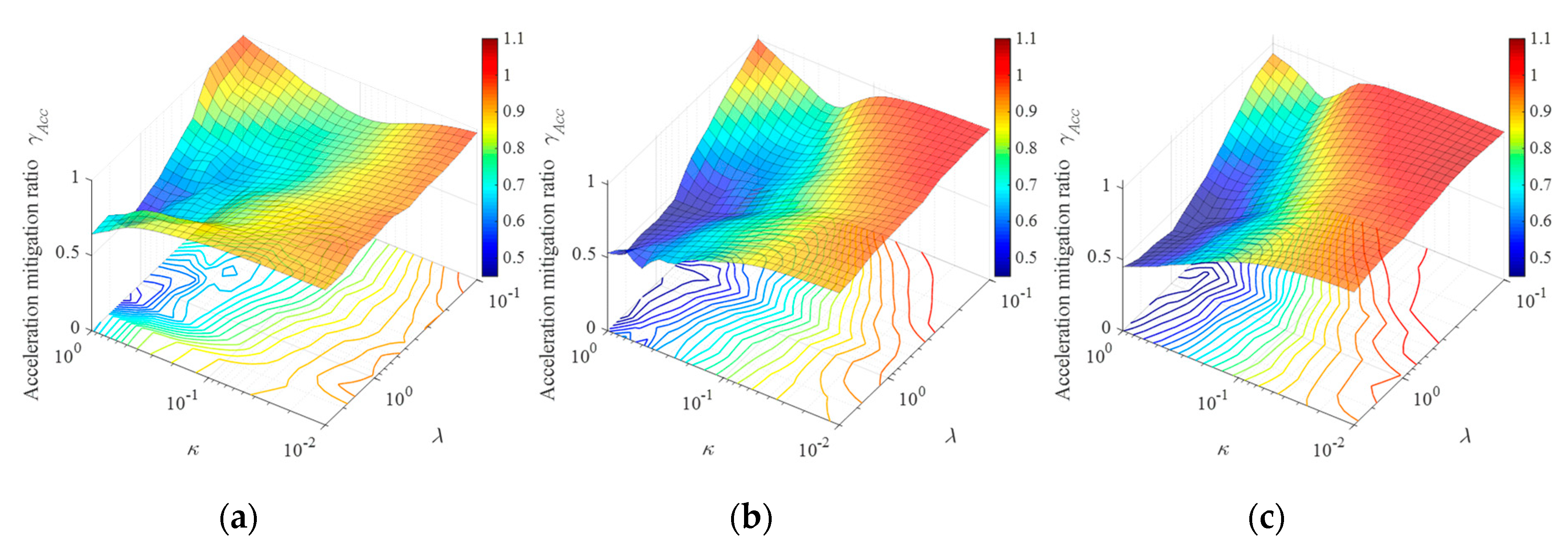


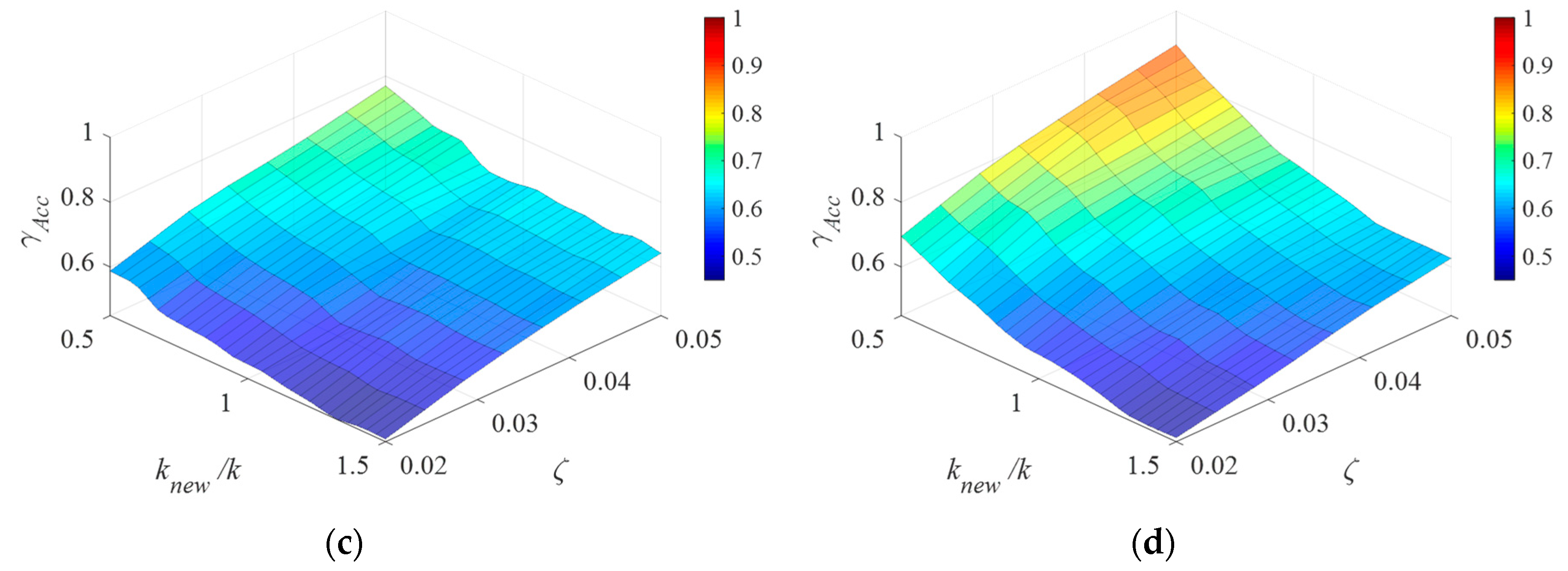
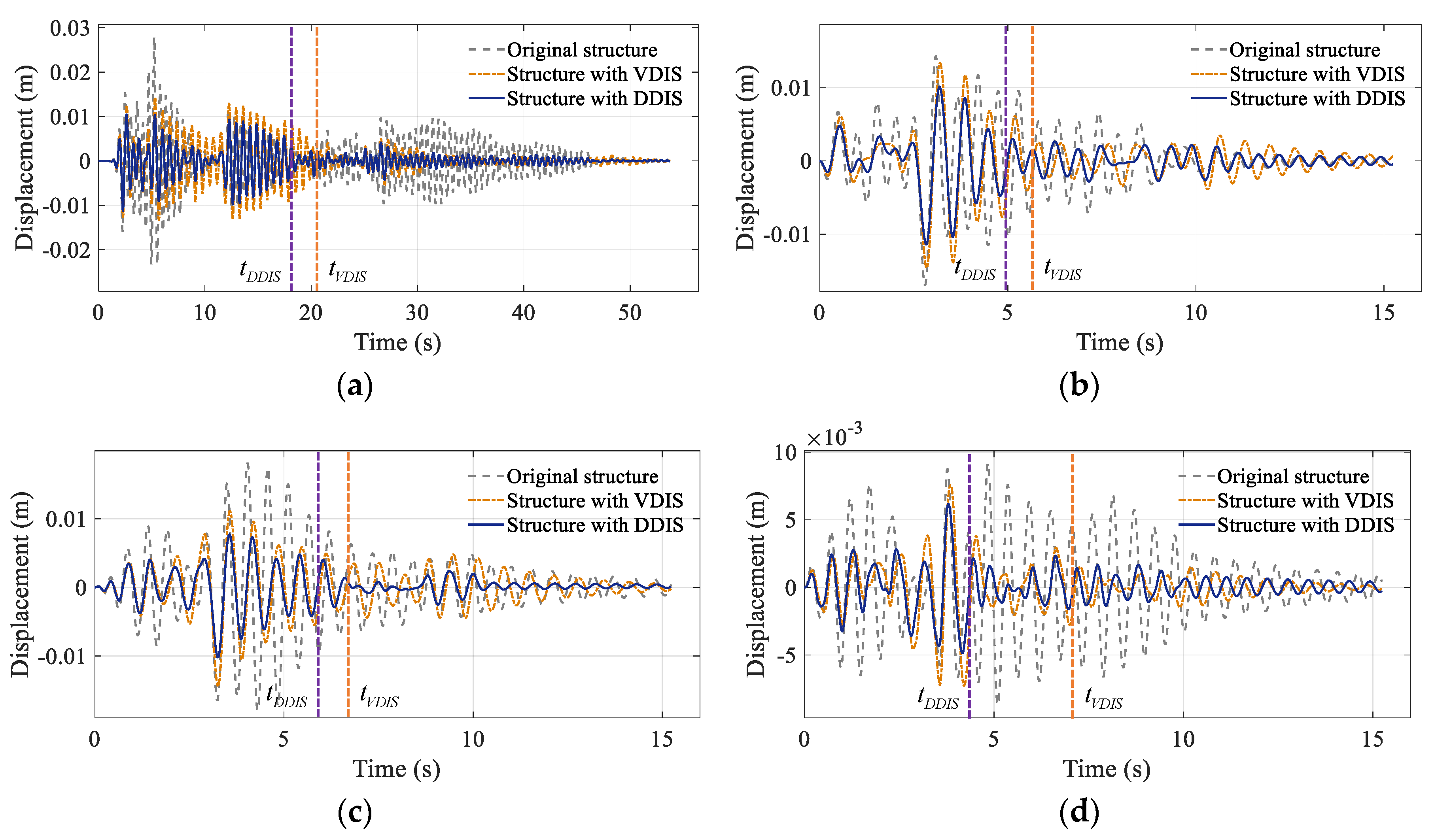
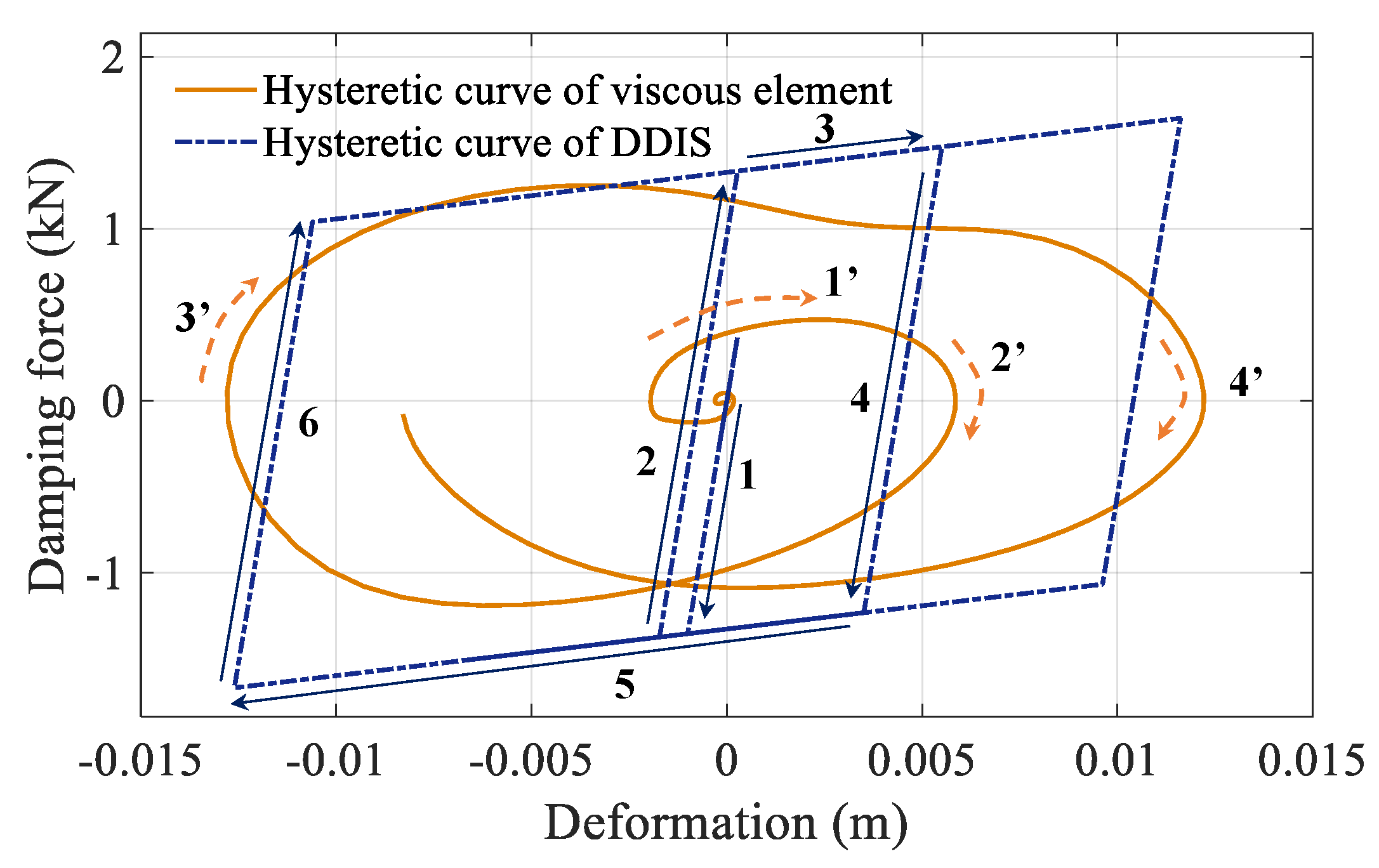

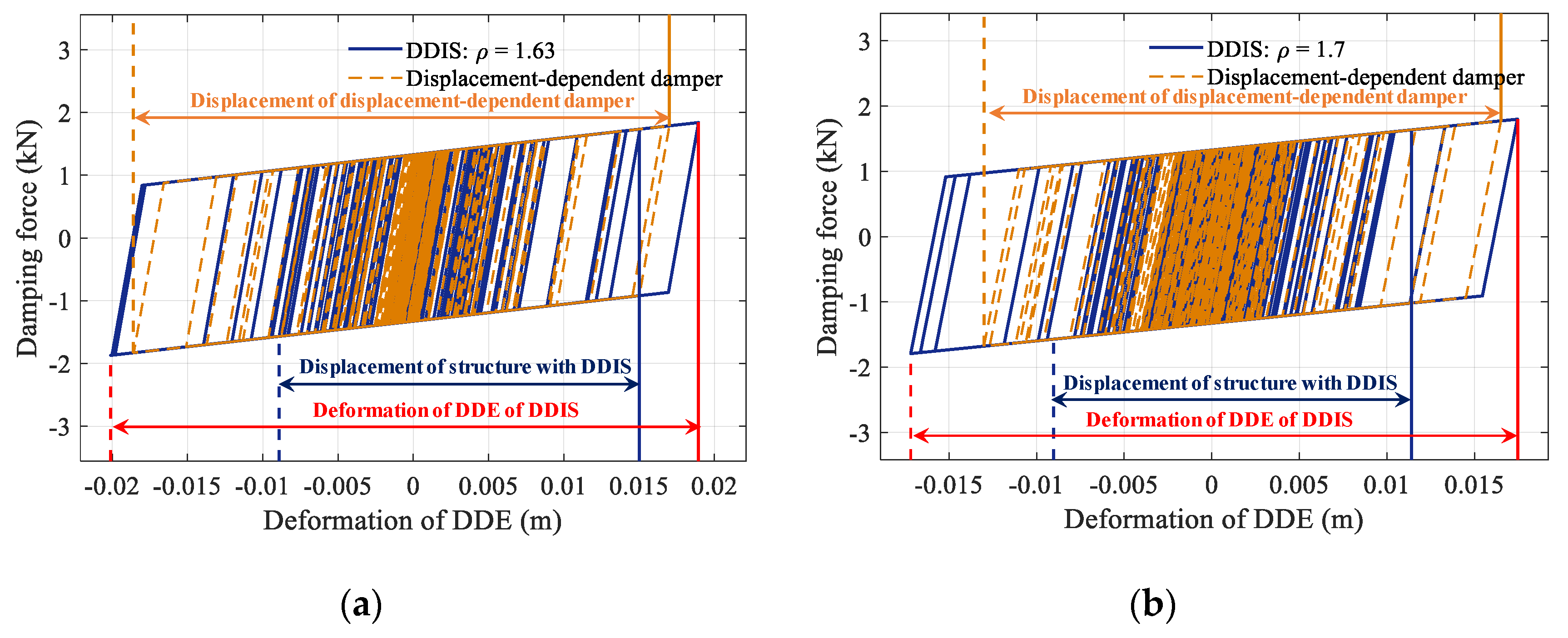
| Type of Excitation | |||
|---|---|---|---|
| LS | 0.47 (0.45) | 0.49 (0.48) | 0.11 (0.10) |
| SS | 0.40 (0.37) | 0.58 (0.54) | 0.15 (0.15) |
| HS | 0.39 (0.40) | 0.70 (0.71) | 0.12 (0.14) |
| El Centro | 0.41 | 0.61 | 0.14 |
© 2019 by the authors. Licensee MDPI, Basel, Switzerland. This article is an open access article distributed under the terms and conditions of the Creative Commons Attribution (CC BY) license (http://creativecommons.org/licenses/by/4.0/).
Share and Cite
Zhao, Z.; Zhang, R.; Jiang, Y.; De Domenico, D.; Pan, C. Displacement-Dependent Damping Inerter System for Seismic Response Control. Appl. Sci. 2020, 10, 257. https://doi.org/10.3390/app10010257
Zhao Z, Zhang R, Jiang Y, De Domenico D, Pan C. Displacement-Dependent Damping Inerter System for Seismic Response Control. Applied Sciences. 2020; 10(1):257. https://doi.org/10.3390/app10010257
Chicago/Turabian StyleZhao, Zhipeng, Ruifu Zhang, Yiyao Jiang, Dario De Domenico, and Chao Pan. 2020. "Displacement-Dependent Damping Inerter System for Seismic Response Control" Applied Sciences 10, no. 1: 257. https://doi.org/10.3390/app10010257
APA StyleZhao, Z., Zhang, R., Jiang, Y., De Domenico, D., & Pan, C. (2020). Displacement-Dependent Damping Inerter System for Seismic Response Control. Applied Sciences, 10(1), 257. https://doi.org/10.3390/app10010257








